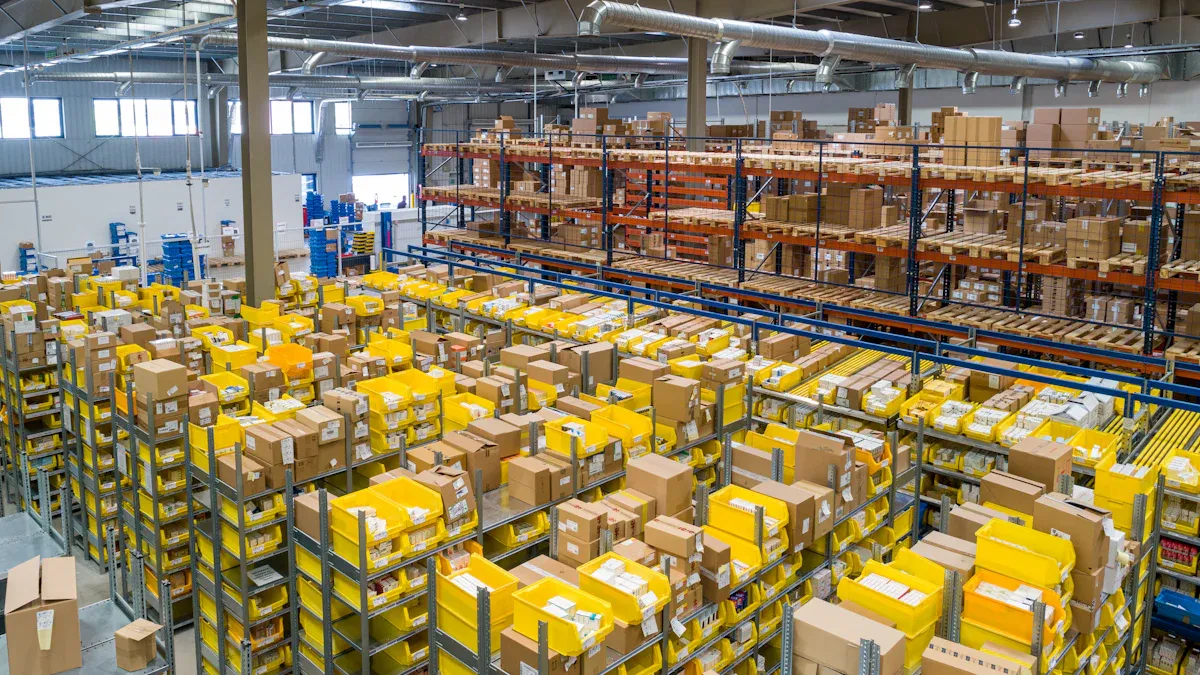For Manufacturing Companies: In-House Warehousing or Outsourcing?

The best warehousing strategy for manufacturing companies depends on their unique production needs and priorities. Cost, control, scalability, expertise, and alignment with business goals shape this decision. Many production leaders see up to a 30% reduction in logistics costs and a 25% boost in order fulfillment after choosing the right warehousing strategy. The chart below shows how operations improve with effective warehousing.
Manufacturing companies should review both in-house and outsourcing options, considering growth and production demands.
Key Takeaways
Manufacturing companies must choose warehousing based on their unique needs, balancing cost, control, and growth plans.
In-house warehousing offers full control and customization but requires higher upfront costs and limits quick scaling.
Outsourced fulfillment lowers costs, speeds up shipping, and scales easily but reduces direct control over operations.
A hybrid model combines both approaches, giving flexibility to handle core products in-house and overflow through outsourcing.
Using a clear decision framework helps companies evaluate their options and adjust their warehousing strategy as business needs change.
Definitions
In-House Warehousing
In-house warehousing means a manufacturing company manages its own storage facilities. The company owns or leases the warehouse space and handles all warehousing operations. Employees from the company control the inventory, track shipments, and oversee the order fulfillment process. This approach gives the company direct control over every step of warehousing and fulfillment.
Many manufacturers choose in-house warehousing to keep sensitive products secure or to maintain strict quality standards. They can customize the warehouse layout to fit their production needs. In-house fulfillment allows the company to respond quickly to changes in demand or production schedules. The company can also integrate warehousing with other business systems, which helps streamline the order fulfillment process.
Tip: In-house warehousing works best for companies with stable order volumes and specialized storage needs.
Outsourced Fulfillment
Outsourced fulfillment means a company hires a third-party fulfillment company to handle warehousing and shipping. The fulfillment company stores products, picks and packs orders, and ships them to customers. This model is also called outsourced warehousing. Many manufacturers use outsourced fulfillment to save on costs and focus on core production activities.
A fulfillment company brings expertise in logistics and can scale operations as order volumes grow. They use advanced technology to track inventory and manage the order fulfillment process. Outsourced fulfillment helps companies reach new markets without investing in new warehouses. It also reduces the need for hiring and training warehouse staff.
Key benefits of outsourced fulfillment:
Lower upfront investment
Faster shipping times
Access to logistics expertise
Manufacturers often choose outsourced warehousing when they want to expand quickly or handle seasonal spikes in order volume.
Key Factors for Manufacturing Companies
Cost
Cost stands as one of the most important factors when manufacturing companies select a warehousing strategy. In-house warehousing requires direct expenses such as rent, insurance, labor, utilities, and supplies. These fixed overhead costs can add up quickly, especially for companies with fluctuating order volumes. In contrast, outsourcing production to third-party logistics providers (3PLs) often means paying per-unit fees that include setup, storage, fulfillment, and shipping. This model eliminates the need for large upfront investments and ongoing overhead.
Factor | In-House Warehousing | Outsourced Fulfillment (3PL) |
|---|---|---|
Warehouse Rental Cost | Average $20 per square foot (U.S.) | No direct overhead; storage fees included |
Shipping Costs | No bulk discounts; higher shipping expenses | Shipping discounts of 15%-35% due to volume |
Overhead Costs | Rent, insurance, labor, utilities, supplies | Costs rolled into per-unit fees |
Customer Retention Impact | Late deliveries risk 69% customer loss | Faster, reliable shipping reduces loss |
Market Loss Due to Delays | Over 10% market loss from delays | Improved fulfillment speed |
Inventory Management | Manual, time-consuming, error-prone | Automated, efficient handling |
Manufacturing companies must weigh these cost implications carefully. In-house production may offer more predictable expenses for stable operations, but outsourcing production can deliver cost savings through bulk shipping rates and reduced overhead. However, the risks of outsourcing include less direct control and possible adjustment periods for new partners.
Control
Control and oversight play a major role in the warehousing decision. In-house warehousing gives companies full authority over inventory management, order fulfillment process, and daily operations. This direct control allows for quick adjustments to production schedules and immediate responses to supply chain disruptions. Companies can monitor every step, from receiving raw materials to shipping finished orders.
Outsourcing production, on the other hand, means trusting a third-party provider with critical operations. While this can free up resources for core production, it may reduce visibility into the order fulfillment process. Some companies find it challenging to maintain the same level of quality assurance and responsiveness with outsourced warehousing. For businesses that require strict quality standards or handle sensitive products, in-house logistics often remains the preferred choice.
Note: Companies that value control and oversight over every aspect of their operations often lean toward in-house warehousing, especially when brand reputation depends on consistent service.
Scalability
Scalability and flexibility determine how well a warehousing strategy supports business growth. In-house warehousing often faces limits due to high capital requirements and long construction times. For example, building a new warehouse in Europe takes an average of 180 days, and the return on investment can stretch to nine years. These barriers make it difficult for manufacturing companies to scale up quickly during periods of rapid growth or seasonal spikes in order volume.
Outsourcing production to 3PLs offers high flexibility and rapid scalability. Providers like Maersk operate hundreds of warehouses and fulfillment sites worldwide, giving companies immediate access to new markets without the need for new construction. In fact, 43% of shippers now outsource warehouse operations to meet changing demand. Outsourced warehousing allows companies to adjust storage space and fulfillment capacity as needed, supporting both short-term surges and long-term expansion.
Expertise
Expertise in warehousing and logistics can drive operational efficiency and inventory optimization. In-house production teams may lack specialized knowledge in advanced logistics, leading to manual processes and higher error rates. Measurement science and statistical techniques, such as control charts, help companies monitor performance metrics and identify improvement opportunities. However, these methods require skilled personnel and ongoing training.
Outsourced logistics providers bring deep expertise in supply chain management, process improvement, and technology. For example, a third-party logistics company using Lean Six Sigma methodology improved process cycle efficiency from 40% to 70%. This level of expertise helps manufacturing companies streamline operations, reduce errors, and enhance the order fulfillment process. Outsourcing production can also provide access to the latest inventory management systems and automation tools, further boosting operational efficiency.
Brand and Integration
Brand alignment and integration with business systems influence customer satisfaction and long-term success. In-house warehousing allows companies to customize processes, implement barcoded inventory systems, and achieve accuracy rates up to 99.9%. This high level of precision supports brand consistency and builds trust with customers. Real-time visibility, automation, and demand forecasting become easier to manage when companies control their own operations.
In-house warehousing enables direct oversight of key performance indicators, such as packers' efficiency and pickers' accuracy.
Companies can align warehousing strategy with business goals by encouraging feedback, setting measurable KPIs, and fostering flexibility.
Outsourced warehousing offers cost savings and operational efficiency but may limit direct control over inventory and supply chain processes.
Integration challenges can arise when outsourcing production, especially if the provider's systems do not align with existing business platforms.
Some companies adopt a hybrid warehousing model to balance the control and brand alignment of in-house logistics with the scalability and cost advantages of outsourcing.
Manufacturing companies must consider how each warehousing strategy supports their brand promise and integrates with their broader operations. The right choice depends on the need for customization, responsiveness, and alignment with long-term business objectives.
Pros and Cons

In-House Warehousing
In-house warehousing gives manufacturing companies direct control over their production and inventory management. They can design the warehouse to fit their in-house production needs. This approach supports in-house logistics and allows for fast responses to changes in order volume. Companies can keep sensitive products secure and maintain high quality standards. In-house warehousing also helps with inventory optimization and operational efficiency.
Pros of in-house warehousing:
Full control over inventory management and order fulfillment
Customizable processes for in-house production
Strong alignment with brand and in-house logistics
Quick response to production changes
Cons of in-house warehousing:
High upfront cost for building or leasing space
Ongoing expenses for labor and equipment
Limited scalability during rapid production growth
Requires expertise in warehousing and operational efficiency
Note: In-house warehousing works best for companies with stable production and predictable order patterns.
Outsourced Fulfillment
Outsourced fulfillment lets companies focus on core production while a third party handles warehousing and shipping. This model supports outsourced warehousing and outsourced logistics. Companies benefit from the expertise of fulfillment providers and gain access to advanced technology. Outsourced fulfillment can improve operational efficiency and lower costs, especially during seasonal spikes in order volume.
Pros of outsourced fulfillment:
Lower upfront cost and reduced overhead
Fast scalability for changing production needs
Access to outsourced logistics expertise
Improved operational efficiency and faster order delivery
Cons of outsourced fulfillment:
Less direct control over inventory management and order fulfillment
Possible challenges with brand alignment
Integration issues with in-house production systems
Dependence on the reliability of the fulfillment partner
The benefits of outsourcing include cost savings and improved operational efficiency, but companies must weigh these against the need for control and integration with in-house production.
Decision Framework
Assessing Needs
Manufacturing companies must start by understanding their unique requirements before choosing a warehousing strategy. Each company faces different challenges in production, fulfillment, and operations. A structured assessment helps leaders identify which model— in-house or outsourcing— aligns best with their goals.
A proven framework organizes the assessment into ten main categories. Each category includes specific sub-criteria that address the full range of warehousing needs. The table below outlines these categories and examples of what companies should evaluate:
Main Criteria | Key Sub-Criteria Examples |
|---|---|
Facilities | Location (transport network, regulations), Number of locations, Layout, Security |
Material Handling Equipment | Best equipment, maintenance, safety training |
Products | Labelling systems, product traceability, waste management |
Processes | Receiving protocols, documentation, health and safety instructions |
Warehouse Management System | Daily planning, resource control, system integration |
Energy Efficiency | Efficient energy systems to reduce costs |
Ethics | Codes of conduct, anti-corruption policies |
Safety | Occupational safety rules, hazard codes, contingency plans |
Quality Management System | Documentation, audits, preventive and corrective actions |
Human Resources System | Training, development, resource planning |
Decision-makers use multi-criteria decision-making methods to weigh these factors. This approach helps them balance the needs of in-house production, fulfillment, and outsourcing production. Companies can prioritize criteria based on their current production scale, cost targets, and long-term warehousing strategy.
Tip: Companies should revisit this assessment regularly as production volumes, customer expectations, and market conditions change.
Evaluation Steps
A step-by-step process ensures that manufacturing companies select the right warehousing strategy for their production and fulfillment needs. The following steps guide leaders through a thorough evaluation:
Define Business Objectives
Leaders must clarify what they want to achieve. Objectives may include reducing cost, improving fulfillment speed, or supporting in-house production growth.Map Current Operations
Companies should document their existing production, warehousing, and fulfillment processes. This step highlights strengths and weaknesses in current operations.Gather Data on Key Performance Indicators
Tracking numerical indicators helps companies measure efficiency and identify pain points. Important indicators include:Inventory turnover: Shows how quickly inventory moves through the warehouse.
Order accuracy: Measures how often orders are fulfilled correctly.
Order cycle time: Tracks the time from order placement to delivery.
Warehouse productivity: Compares output to resources used.
Inventory levels and safety stock: Monitors stock to prevent shortages.
Forecasting and demand planning: Uses past data to predict future needs.
Streamlining order and replenishment processes: Improves order management and customer satisfaction.
Compare In-House and Outsourcing Models
Leaders should analyze how each model supports their production, fulfillment, and warehousing strategy. They must consider cost, scalability and flexibility, control, and integration with in-house production.Score and Prioritize Criteria
Using decision-making tools, companies can assign weights to each criterion. This step helps them see which warehousing strategy best fits their production and fulfillment needs.Pilot and Review
Companies may test a new model on a small scale. They should monitor performance and adjust their warehousing strategy as needed.
Note: A structured evaluation reduces risk and supports better long-term decisions for production and fulfillment.
When to Switch
Manufacturing companies may need to change their warehousing strategy as their production environment evolves. Certain triggers signal when a switch from in-house to outsourcing production—or vice versa—may benefit the business.
Key triggers include:
Inventory turnover drops or becomes inconsistent.
Order accuracy falls below industry benchmarks.
Order cycle time increases, leading to late deliveries.
Warehouse productivity declines, raising operational costs.
Inventory levels become too high or too low, causing stockouts or excess.
Forecasting and demand planning fail to match actual production needs.
Order and replenishment processes become slow or error-prone.
When these indicators show persistent problems, leaders should consider a new warehousing strategy. Outsourcing production may offer better fulfillment and scalability. In-house production may regain control and improve integration with core operations.
Long-term considerations include:
Projected growth in production and fulfillment volumes.
Changes in customer expectations for speed and accuracy.
Shifts in cost structures or supply chain risks.
The need for advanced technology or specialized expertise.
Companies that monitor these triggers and review their warehousing strategy regularly stay agile and competitive in a changing market.
Hybrid Models

What Is a Hybrid Model
A hybrid warehousing model combines in-house production with outsourcing production. Companies use both in-house and outsourcing strategies to manage their production and storage needs. In this model, a company may keep some inventory in its own warehouse while sending other products to a third-party provider. This approach gives companies flexibility. They can use in-house resources for core production and sensitive items. At the same time, they can rely on outsourcing for overflow storage or to reach new markets.
Hybrid models help companies balance control and efficiency. In-house teams can focus on high-value production tasks. Outsourcing partners can handle routine or high-volume orders. This mix supports companies that want to keep some control but also need the benefits of outsourcing. Many manufacturers use hybrid models during periods of rapid production growth or when entering new regions.
Tip: Hybrid models work well for companies with changing production needs or seasonal spikes.
When to Use Hybrid
Companies often choose a hybrid model when neither in-house production nor outsourcing production alone meets all their needs. For example, a business may use in-house warehousing for products that require special handling. At the same time, it may use outsourcing for fast-moving or less sensitive items. This strategy helps companies manage risk and improve production efficiency.
A hybrid model fits best when:
Production volumes change often.
The company wants to test new markets without large investments.
In-house capacity cannot meet peak demand.
The business needs to keep some production steps close for quality control.
Hybrid models also support companies that want to scale quickly. They can add outsourcing partners as production grows. In-house teams can focus on core production and brand standards. Outsourcing partners can provide extra space and logistics support.
Note: Companies should review their production goals and resources before choosing a hybrid model. The right mix of in-house and outsourcing depends on the company’s unique production challenges.
Manufacturing companies must choose warehousing based on their unique production needs. Each production environment changes over time. Cost, control, scalability, expertise, and strategic alignment shape the best production strategy. A structured decision framework helps leaders compare options for production warehousing. Companies should review production processes often. Production requirements may shift as markets grow. Flexibility in production planning supports long-term success. Leaders can consult logistics experts for production advice. Piloting new production solutions gives valuable insights. The right production model supports growth and efficiency.
FAQ
What is the main difference between in-house and outsourced warehousing?
In-house warehousing means a company manages its own storage and shipping. Outsourced warehousing uses a third-party provider for these tasks. Each option affects control, cost, and how well the company supports its production goals.
How does warehousing impact production efficiency?
Warehousing supports production by keeping materials and products organized. Good warehousing reduces delays and errors. When companies choose the right model, they improve production speed and meet customer needs faster.
When should a company switch its warehousing strategy?
A company should consider switching if it sees slow order fulfillment, rising costs, or trouble meeting production targets. Growth, new markets, or changing customer demands also signal the need to review warehousing choices.
Can a hybrid model help with seasonal production spikes?
A hybrid model gives companies flexibility. They can use in-house space for regular production and outsource extra storage during busy seasons. This approach helps manage costs and keeps production running smoothly.
What risks come with outsourcing warehousing?
Outsourcing can reduce control over inventory and production processes. Companies may face challenges with quality, communication, or system integration. Choosing a reliable partner helps lower these risks.
See Also
Improving Supply Chain Strategies For Advanced Manufacturing Challenges
How Robotic Automation Enhances Warehouse Efficiency And Operations
Mastering Lean Logistics To Drive Success In High-Tech Manufacturing
Exploring The Advantages Of Automation In High-Tech Warehousing
Leveraging Robotics Technology To Boost Warehouse Productivity Levels
